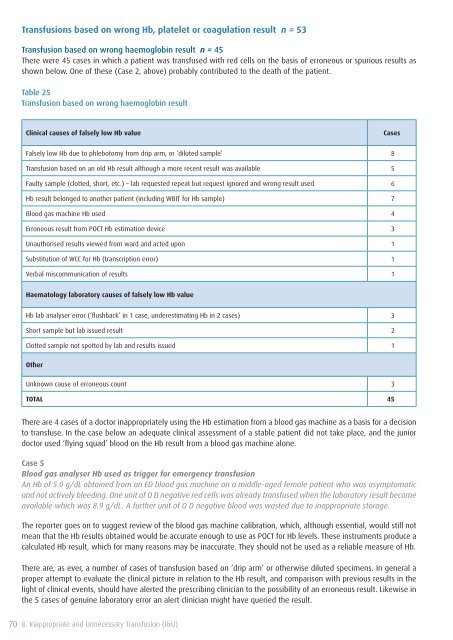SHOT Annual Report 2009 - Serious Hazards of Transfusion
SHOT Annual Report 2009 - Serious Hazards of Transfusion
SHOT Annual Report 2009 - Serious Hazards of Transfusion
You also want an ePaper? Increase the reach of your titles
YUMPU automatically turns print PDFs into web optimized ePapers that Google loves.
<strong>Transfusion</strong>s based on wrong Hb, platelet or coagulation result n = 53<br />
<strong>Transfusion</strong> based on wrong haemoglobin result n = 45<br />
There were 45 cases in which a patient was transfused with red cells on the basis <strong>of</strong> erroneous or spurious results as<br />
shown below. One <strong>of</strong> these (Case 2, above) probably contributed to the death <strong>of</strong> the patient.<br />
Table 25<br />
<strong>Transfusion</strong> based on wrong haemoglobin result<br />
Clinical causes <strong>of</strong> falsely low Hb value<br />
Cases<br />
Falsely low Hb due to phlebotomy from drip arm, or ‘diluted sample’ 8<br />
<strong>Transfusion</strong> based on an old Hb result although a more recent result was available 5<br />
Faulty sample (clotted, short, etc.) – lab requested repeat but request ignored and wrong result used 6<br />
Hb result belonged to another patient (including WBIT for Hb sample) 7<br />
Blood gas machine Hb used 4<br />
Erroneous result from POCT Hb estimation device 3<br />
Unauthorised results viewed from ward and acted upon 1<br />
Substitution <strong>of</strong> WCC for Hb (transcription error) 1<br />
Verbal miscommunication <strong>of</strong> results 1<br />
Haematology laboratory causes <strong>of</strong> falsely low Hb value<br />
Hb lab analyser error (‘flushback’ in 1 case, underestimating Hb in 2 cases) 3<br />
Short sample but lab issued result 2<br />
Clotted sample not spotted by lab and results issued 1<br />
Other<br />
Unknown cause <strong>of</strong> erroneous count 3<br />
TOTAL 45<br />
There are 4 cases <strong>of</strong> a doctor inappropriately using the Hb estimation from a blood gas machine as a basis for a decision<br />
to transfuse. In the case below an adequate clinical assessment <strong>of</strong> a stable patient did not take place, and the junior<br />
doctor used ‘flying squad’ blood on the Hb result from a blood gas machine alone.<br />
Case 5<br />
Blood gas analyser Hb used as trigger for emergency transfusion<br />
An Hb <strong>of</strong> 5.0 g/dL obtained from an ED blood gas machine on a middle-aged female patient who was asymptomatic<br />
and not actively bleeding. One unit <strong>of</strong> O D negative red cells was already transfused when the laboratory result became<br />
available which was 8.9 g/dL. A further unit <strong>of</strong> O D negative blood was wasted due to inappropriate storage.<br />
The reporter goes on to suggest review <strong>of</strong> the blood gas machine calibration, which, although essential, would still not<br />
mean that the Hb results obtained would be accurate enough to use as POCT for Hb levels. These instruments produce a<br />
calculated Hb result, which for many reasons may be inaccurate. They should not be used as a reliable measure <strong>of</strong> Hb.<br />
There are, as ever, a number <strong>of</strong> cases <strong>of</strong> transfusion based on ‘drip arm’ or otherwise diluted specimens. In general a<br />
proper attempt to evaluate the clinical picture in relation to the Hb result, and comparison with previous results in the<br />
light <strong>of</strong> clinical events, should have alerted the prescribing clinician to the possibility <strong>of</strong> an erroneous result. Likewise in<br />
the 5 cases <strong>of</strong> genuine laboratory error an alert clinician might have queried the result.<br />
70 8. Inappropriate and Unnecessary <strong>Transfusion</strong> (I&U)












